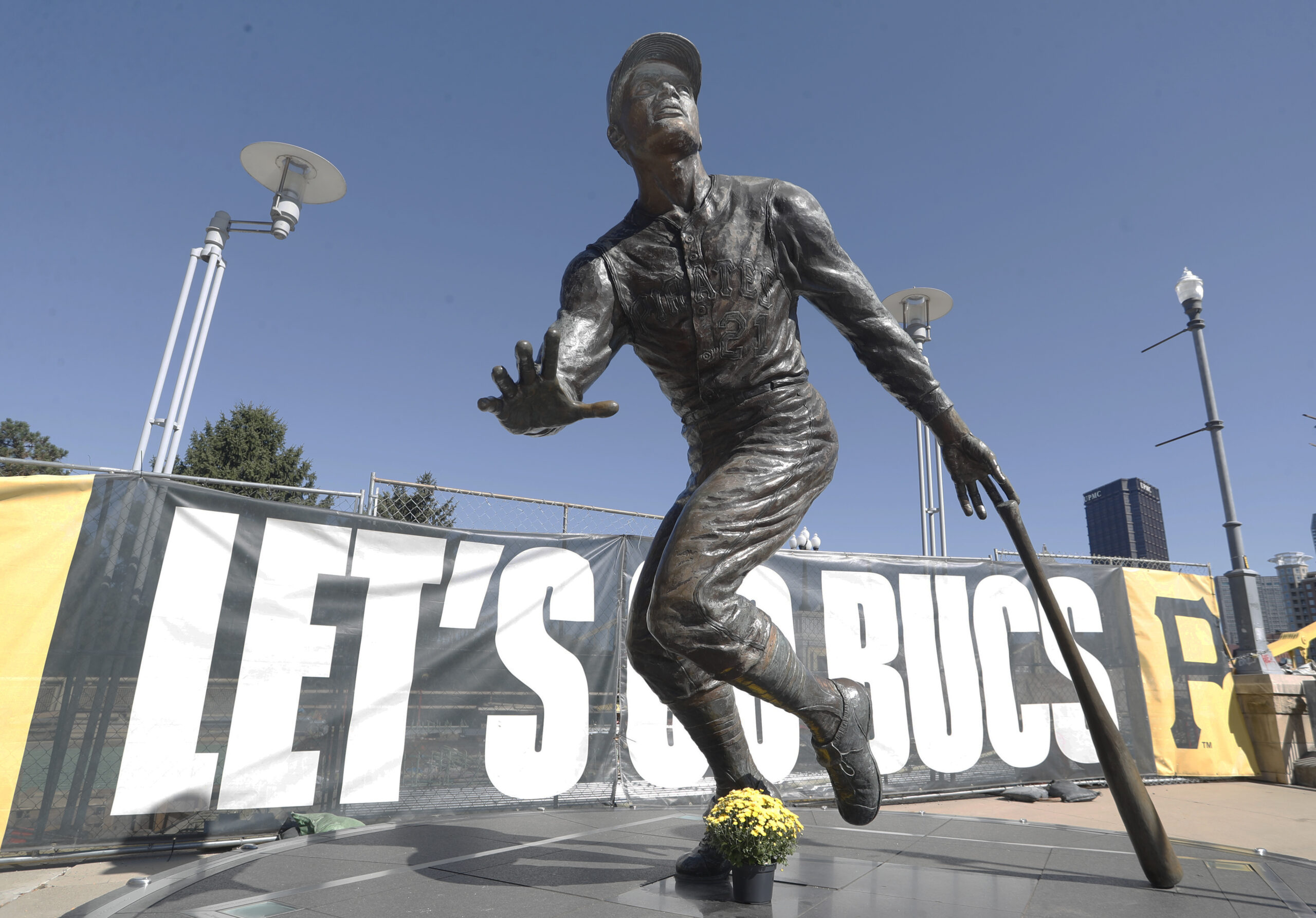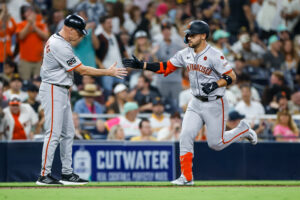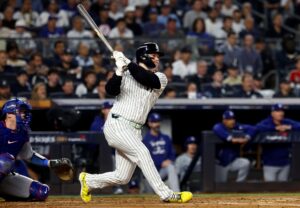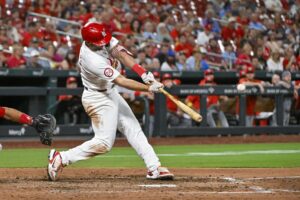This Sunday, September 15, is Roberto Clemente Day throughout Major League Baseball. Established in 2002, it’s an annual celebration of the Hall-of-Famer and former Pittsburgh Pirates right fielder’s legacy as a humanitarian. Clemente was killed in a plane crash on New Year’s Eve, 1972, while on a mercy mission to deliver relief supplies to earthquake victims in Managua, Nicaragua.
Major League Baseball To Celebrate Roberto Clemente Day
Our story begins on October 3, 1951. The New York Giants hosted the Brooklyn Dodgers in the deciding Game 3 of a National League postseason series necessitated by a first-place deadlock during the regular season. The Dodgers’ big right-hander Don Newcombe was tiring in the bottom of the ninth inning with his team ahead, 4-1. After he let a second run in and had two runners on base, Dodgers manager Chuck Dressen phoned his bullpen. He asked bullpen coach Clyde Sukeforth which of the two pitchers warming up looked better. Sukeforth recommended Ralph Branca, who promptly served up “The Shot Heard ‘Round the World” to Bobby Thomson. Dressen publicly blamed Sukeforth. Thus, unceremoniously thrown under the bus, Sukeforth was either fired or resigned.
Sukeforth joined the Pirates as a coach/scout. In 1954, Pirates general manager Branch Rickey sent Sukeforth to Montreal, the Dodgers’ Triple-A club, to scout pitcher Joe Black for a possible trade. Sukeforth came away more impressed with a first-year 19-year-old Puerto Rican outfielder. The Pirates selected Clemente in the Rule 5 Draft on the day of November 22, 1954.
A Man Alone
Since his death, there’s been much revisionist history about Clemente’s relationship with his teammates. The fact is that most of them didn’t like him when he joined the Pirates in 1955. Although he had just one single minor league season under his belt, they were intolerant of his rookie mistakes. There was a language barrier as Clemente tried to fit in with American culture. When people asked him how he felt, he thought they sincerely wanted to know, so he’d tell them his arm was sore, his leg hurt, etc. Thus, he was labeled a hypochondriac. Clemente kept a notebook each day, detailing where he was injured or sore and worked out to strengthen those muscles. Teammates ridiculed him for it.
Yeah, he was stupid all right. He was ahead of his time with his workout regimen. In his final season at age 37, he hit .312, just six points below his lifetime average entering the year. He fielded 1.000 in right field and won his 12th consecutive Gold Glove Award. Many of his contemporaries who’d been All-Star outfielders were moved to the less-demanding first base. He had a longer career than those teammates who laughed at him.
Bobby Bragan, who took over as Pirates manager in 1956, appreciated Clemente. On July 25, 1956, Clemente hit the only walk-off inside-the-park grand slam in baseball history. In doing so, he ran through the stop sign of Bragan, who was coaching third base. “Fine him?” said Bragan afterward, repeating a reporter’s question. “Definitely not. He’s winning for us, isn’t he?”
Wild About Harry
Clemente remained a loner, even on the 1960 world champion Pirates, for whom he hit .314/.357/.458, 16 HR, and 94 RBI in the regular season before hitting safely in all seven World Series games. In 1957, Danny Murtaugh had taken over for Bragan, and he and Clemente didn’t always get along. When Murtaugh retired after the 1964 season, Harry Walker took over. By then, Clemente had his first two of four batting titles under his belt. Even so, strange as it may seem, it was under Walker that Clemente became an even more complete hitter. Clemente was becoming a respected leader, too. The players who didn’t like him were gone for the most part. Furthermore, the Pirates had more black and Latin American players than they had in 1960. Clemente could relate to them and vice-versa.
Clemente won another batting title in 1965, but as the 1966 season approached, Walker urged Clemente to hit for more power. Walker liked Clemente’s stroke to all fields but told him not to be satisfied with singles. Clemente had his best season in 1966, hitting .317/.360/.536, 29 HR, and 119 RBI, and would win his only National League Most Valuable Player Award. The day after Clemente won the award, he told Charley Feeney of the Pittsburgh Post-Gazette, “Harry Walker is tops in my book. . . Maybe he is not the best manager there is, but to me he is tops.”
“I Never Cared About Hitting Homers”
If there was one criticism about Clemente, it was that he didn’t hit for power. For his 18-year career, he hit .317/.359/.475, 240 HR, and 1,305 RBI. That same interview with Feeney lends some insight into Clemente’s hitting philosophy. Clemente said, “I never cared about hitting homers. I think a .350 batting average does the same good for a team as 25 homers and 100 runs batted in. But, of course, if Walker wants more homers, it’s okay with me.”
No less an authority than Willie Mays thought Clemente was the best player he ever saw, power-hitting be damned.
Clemente’s Showcase
The 1971 World Series, which the Pirates won over the Baltimore Orioles in seven games, was Clemente’s personal showcase. Murtaugh had returned to manage the Pirates, and all was well between him and his superstar. Clemente again hit safely in all seven games. Clemente was 12-for-29 with two doubles, a triple, two homers and four RBI and was named the World Series MVP. He wowed the national TV audience with his defense and laser throws from right field.
He never got much national attention playing in small market Pittsburgh – Sports Illustrated would ignore his 3,000th hit and devote a single paragraph to his death – but now the nation’s baseball fans knew all about him. In the locker room celebration, Pirates first base coach Don Leppert told Bill Christine of The Pittsburgh Press, “I’ll bet (Orioles general manager) Harry Dalton would trade half his ball club for Clemente.”
“I Had to Get The Hit Today”
Clemente got hit number 3,000 against the New York Mets at Three Rivers on September 30, 1972. It was a day game after Clemente had gone hitless against Tom Seaver the night before. Clemente revealed he had been on the phone until 4:30 AM after Friday’s game and didn’t bother going to bed. “I knew I had to get the hit today,” he said to Bob Smizik of The Pittsburgh Press, “because I couldn’t afford to go through that another night.”
Finally, it happened in the fourth inning when Clemente struck a 0-1 pitch from left-hander Jon Matlack into the left-center field gap for a double. After the inning, his friend Mays walked over to the Pirates dugout to congratulate him. It was the final regular season hit of Clemente’s career.
Today there is a statue of Clemente outside the center field gate at PNC Park and a Clemente Museum in the Lawrenceville section of Pittsburgh. Open by appointment only, the museum is worth checking out for its astounding, seemingly endless collection of memorabilia.
On Roberto Clemente Day
On Sunday, a tribute video to Clemente’s legacy and the Roberto Clemente Award nominees from each team will be shown in all MLB ballparks in English and Spanish. All Pirates players, coaches, and their manager will wear number 21 on their uniforms. As for the other 29 teams, all current nominees and past award winners may wear number 21 if they choose. All active award winners will wear a “21” patch on the back of their caps. All bases will be adorned with the logos of MLB Together, which is MLB’s community and social responsibility platform, and Capital One, in honor of, one supposes, society’s mounting credit card debt. If you’re going, check your team’s website for more details.
Main Photo Credits: Charles LeClaire-Imagn Images






